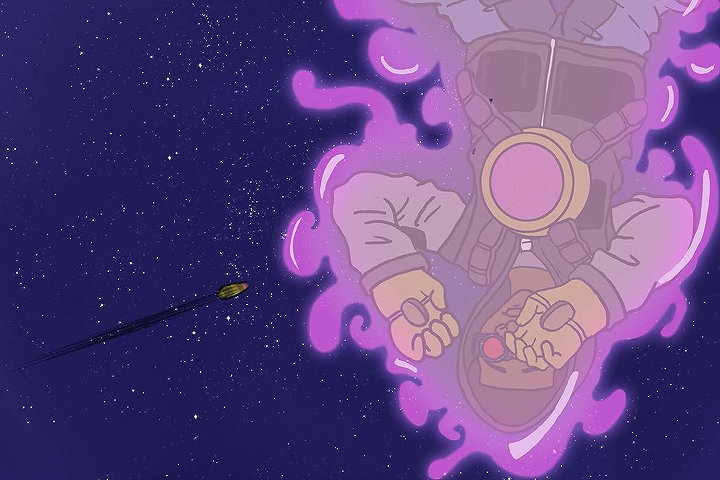Writer and artist Bryan Angrand challenges several difficult but important and relevant themes in IQ: The Story of Isaac Quentin. The story begins with a shocking jump start as three unsuspecting teenagers face the barrel of a police officer’s gun. This quick little snippet fades out into the life of our main character, Isaac Quentin. Firstly, it goes through his early childhood as a toddler with an extremely high IQ. As the years move forward, we see how his father’s absence affects him growing up. Isaac grows through life with the support system of his mother and friends. All that is happy and dandy—until that one horrible encounter on the first page.
IQ: The Story of Isaac Quentin’s first volume has five chapters. Each chapter’s title represents the trajectory of the story, providing markers for the readers. They’re also red herrings with something deeper hidden underneath. The graphic novel tries to tackle several difficult subject matters such as gun violence, police brutality towards Black people, racism and survivor’s guilt. All of these are heavy topics. But they’re extremely detrimental in telling the story of our hero. Oh, did I forget to mention this is a superhero story? Well, it is—complete with its own cliché backstory of missing fathers. Think The Amazing Spider-Man, Iron Man and My Hero Academia.
Unlike most superhero comics, this one doesn’t revolve around a hero with powers. All he has are his smarts and the ingenuity to create gadgets. I kind of prefer that. Speaking of gadgets, I love how creative they’ve been so far. There are only two in showcase, but they’re very interesting in concept and execution. They open the main character up to a bunch of crazy shenanigans and still incite clever ways of using. Some of the ideas are ones I’ve yet to see in other media before. I especially like the goggles that use chemicals to determine attraction.
Of course, gravity manipulation isn’t quite new. But I like that it’s less like Uraraka’s quirk in My Hero Academia and more like Chuuya’s ability in Bungo Stray Dogs. There’s a bit of a twist in the end about superhuman abilities – but I’ll let you figure that out on your own. Aside from that, there are other parts of the graphic novel that remind me of other pieces of media. For example, the art is very reminiscent of old cartoons from my childhood. It reminds me a lot of The Boondocks, Shaman King (2001) and a little bit of Soul Eater. They’re not exact matches in terms of style. But they do use several of the same techniques; it’s the dark edges, thick black lines, big eyes, detailed facial features and structures such as the shape of their nose.
Overall, I see a lot of similarities in the art and color to Through Your Lens. Speaking of color, one of the things I love in this comic’s use of it is the fact that Angrand doesn’t just use one shade of black and brown – it varies from character to character. Don’t let the bright and vibrant colors fool you though. There’s tragedy in the story; enacting scenes from real life that we see all the time in the news, viral videos and social media posts.
I also really love the suit design for IQ. It’s modest, yet seemingly functional. The hood reminds me of modernized superhero outfits. Think Miles Morales in Spider-Man: Into the Spider-Verse or Damian Wayne and Jon Kent in Super Sons. But it also has classic touches of old-school heroes such as Havok and Cyclops from the X-Men. The last thing to note about the visuals are the simple panel placements and layouts. Part of IQ: The Story of Isaac Quentin’s charm is his intelligence. This is shown through his inventions and tons of scientific explanations. There’s a lot of that kind of jargon throughout the novel. But thanks to the simplicity of the layout, everything reads easily and in a digestible manner.
However, I think the most important discussion here is how Angrand tackles the themes. A lot of it is on how surroundings, environment and struggles can shape people’s lives. It’s that whole thing about how all of that can impact people’s personalities and choices. There’s a line I feel that encompasses well the struggle within the comic – and in society in general. “All this did was reopen a scar that didn’t quite heal yet”. This is the perfect analogy for every single time the world makes progress on equality and justice, and the steps taken back when shootings and acts of discrimination by people in power happen. It’s a powerful quote, and the takeaway from this piece by Angrand.
Of course, there’s one more theme I appreciate as well. This theme is one found in My Hero Academia and Spider-Man: Homecoming: “If you can do the things that I can, and you don’t, and bad things happen – they happen because of you.”
Do you want a superhero story that goes deeper than the colorful outfits and glam of superpowers? Want a discussion on racial issues, gun violence and police brutality? Give IQ: The Story of Isaac Quentin a chance. It’s currently running on Kickstarter right now and has already surpassed its goal. If you want to have more nuanced discussions regarding the comic, be sure to message us on Twitter and Instagram.

